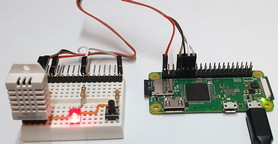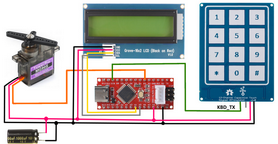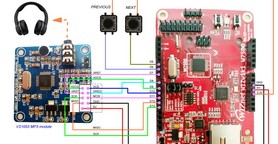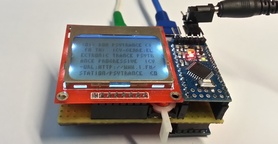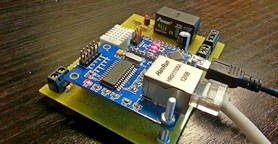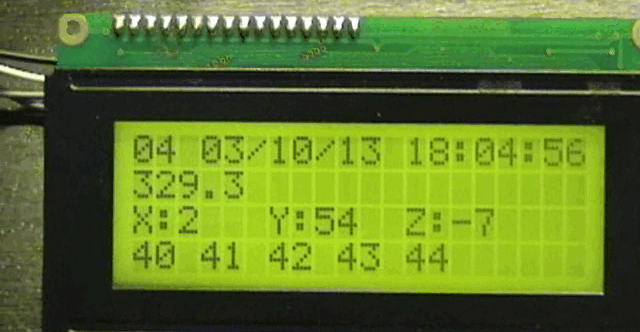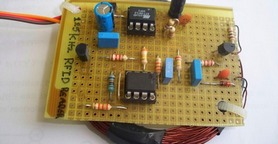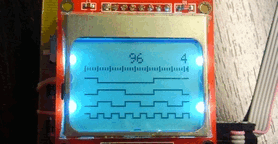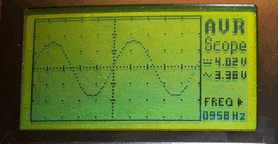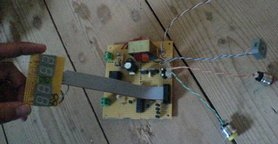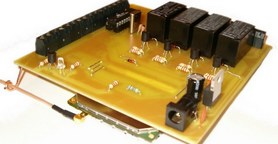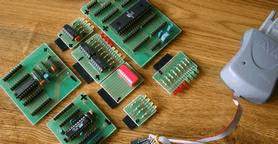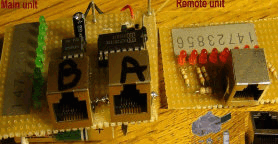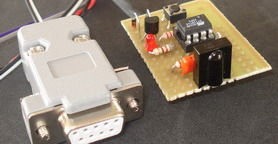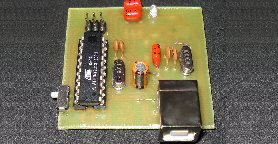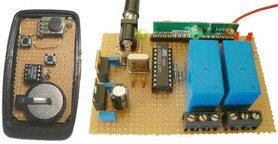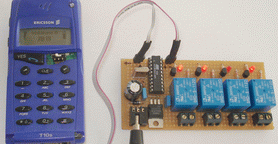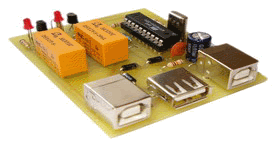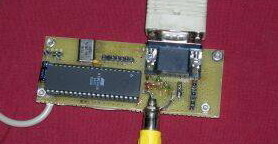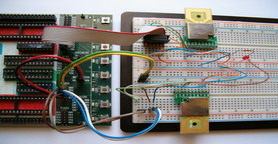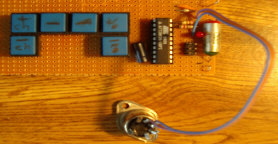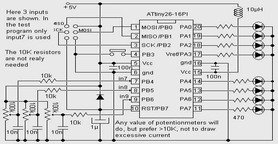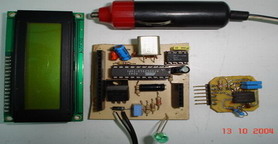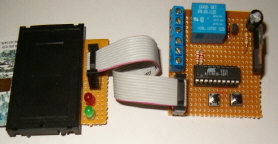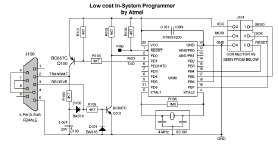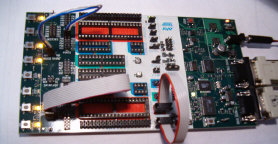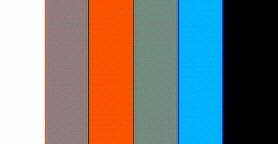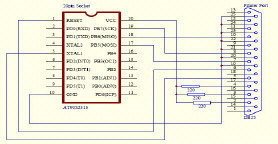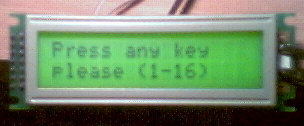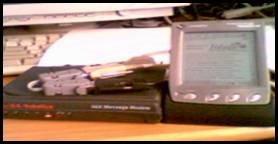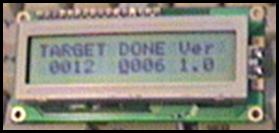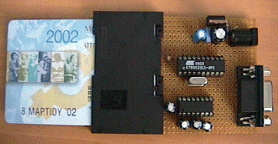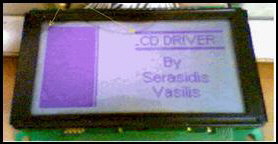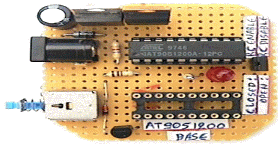

Dear friends,
On this web site, you will find many circuits based on AVR micro-controllers (ìC) from Atmel. The purpose of my web site is to help you work with these little powerful integrated circuits, known as micro-controllers. I will be adding more circuits, because micro controllers, are used in a lot of applications.
I believe you will be helped a lot by the source code of the projects I published on my web site.
Todays, microcontrollers are very advanced. All microControllers contain FLASH memory, USART, RAM, EEPROM, SPI, TWI (I2C) and many more features like USB, CAN, DAC, all in one chip at very low cost.Micro-controllers are ideal for developing applications such as remote control by mobile phone, monitoring temperatures, pressures, air/liquid flow, driving LCD screens, electric motors, custom measuring instrument tools (oscilloscopes, volt meters etc), web servers/clients and many more.
The only limit is the end of your imagination! Be creative!
Happy reading,
Vassilis Serasidis
On this web site, you will find many circuits based on AVR micro-controllers (ìC) from Atmel. The purpose of my web site is to help you work with these little powerful integrated circuits, known as micro-controllers. I will be adding more circuits, because micro controllers, are used in a lot of applications.
I believe you will be helped a lot by the source code of the projects I published on my web site.
Todays, microcontrollers are very advanced. All microControllers contain FLASH memory, USART, RAM, EEPROM, SPI, TWI (I2C) and many more features like USB, CAN, DAC, all in one chip at very low cost.Micro-controllers are ideal for developing applications such as remote control by mobile phone, monitoring temperatures, pressures, air/liquid flow, driving LCD screens, electric motors, custom measuring instrument tools (oscilloscopes, volt meters etc), web servers/clients and many more.
The only limit is the end of your imagination! Be creative!
Happy reading,
Vassilis Serasidis
Control sensors from Raspberry Pi in real-time through a web browser
Designed by:
Vassilis Serasidis (c) 20 November 2020
Published:
7 January 2022
Language:
Python3 and HTML
A simple and easy-to-use electronic safety lock based on the Arduino Nano board. Enter the preset password via the 12-key touchpad. If the password is correct, the circuit rotates the Servo Motor a few degrees to open the door latch mechanically.
Designed by:
Vassilis Serasidis (c) 20 February 2020
Published:
28 February 2020
IDE:
Arduino
A WebRadio station player that plays audio streams up-to 320-kbps.
Few components (as always !) with great sound quality. The new version is based on the 32-bit Cortex-M0 MCU the WIZwiki-W7500 board.
Few components (as always !) with great sound quality. The new version is based on the 32-bit Cortex-M0 MCU the WIZwiki-W7500 board.
Designed by:
Vassilis Serasidis (c) 05 September 2015
Published:
17 September 2015
IDE:
mbed
An inexpensive WebRadio station player that plays audio streams up-to 64-kbps.
Few components (as always !) with great sound quality!
Few components (as always !) with great sound quality!
Designed by:
Vassilis Serasidis (c) 05 October 2014
Published:
17 October 2014
IDE:
Arduino
Remote control your electrical devices through your local network or internet. The circuit contains one output (Relay) and one input (isolated input). The whole project is made in arduino nano platform with ENC28J60 ethernet module. The controlling software "Network relay" was written for Android devices and is available on Google play .
Designed by:
Vassilis Serasidis (c) 06 September 2014
Published:
10 September 2014
IDE:
Arduino
Connect TWI (I2C) sensors to ATmega8 (AVR) microcontroller. This project connects ATmega8 with 24c32 eeprom, GY26 digital compass LIS302DL accelerometer, DS1307 Real Time Clock and PCT8574T I2C to parallel converter to control a 20x4 LCD.
Designed by:
Vassilis Serasidis (c) 29 September 2013
Published:
3 October 2013
IDE:
AVRstudio 6
This RFID reader is based on a small 8 pin micro-controller (ATtiny13) and an Operational Amplifier (LM358). The reading-decoding and output the unique ID serial number of RFID tag is made entire in software by ATtiny13. No special chip is used!
Designed by:
Vassilis Serasidis (c) 28 August 2012
Published:
21 May 2013 | Updated to v2.01 on 12 June 2014
IDE:
AVRstudio 6
A mini Logic Analyzer wich has 4 inputs, it's portable (55x65 mm), battery powered and can capture data up to 400kHz.
Designed by:
Vassilis Serasidis (c) 02 January 2012
Published:
02 January 2012
IDE:
AVRstudio 4 + WinAVR
A mega32 based low speed oscilloscope. It can be used to measure signals from 10Hz up to 7.7 kHz. The input voltage range can be up to 24V AC or 30V DC.
Designed by:
Vassilis Serasidis (c) 01 December 2007
Published:
01 December 2007 | Updated to v2.0 on 19 March 2011
IDE:
AVRstudio 4 + WinAVR
Tired of spending hours and hours in wire soldering? Do your circuits look ugly and you are looking for a way to produce professional-like PCBs? Then you had better try photoetching. And the first step to do that is to have the right equipment that is an Automated Exposure Box
Designed by:
Antonios Theodosiou (c) Sept.2010
Published:
25.Nov.2010
IDE:
AVRstudio 4 + WinAVR
This is the the 3rd version of the famous SMS remote control. The older T10s cell phone has been replaced by the GM-47 GSM module by allowing you to find easier this module. Moreover, 8 inputs were added for collecting data from switches (windows, doors, limit switches and more). The SMS is now protected by a password.
Designed by:
Vassilis Serasidis (c) Jan.2006
Published:
27.Jul.2010
IDE:
AVRstudio 4 (AVR assembly)
A simple and small AVR board to develop your applications. It consists of few, cheap and ordinary components like LEDs, Voltage regulator and capacitors.
Designed by:
Vassilis Stergiopoulos (c) 26.Jul.2010
Published:
26.Jul.2010
IDE:
AVRstudio 4 + (AVR Assembly)
Here's a very simple, but practical circuit, which is used to check the type of LAN cables (straight or cross) as well as possible faults. So we use a unit that has 8 outputs, each one of which produces a pulse successively.
Designed by:
Vassilis Stergiopoulos (c) 01.May.2010
Published:
01.May.2010
IDE:
AVRstudio 4 + (AVR Assembly)
You can control now your media center with this programmable RC5 receiver. Moreover, you can switch On/Off your Media Center by your remote control.
Designed by:
Vassilis Serasidis (c) 08.Oct.2007
Published:
08.Oct.2007
IDE:
AVRstudio 4 + WinAVR
USB AVR programmer that supports a lot of AVR micro-controllers.
Designed by:
Klaus Leidinger , Dimitris Porlidas , Mike Henning and Vassilis Serasidis on (c) 08.Oct.2007
Published:
08.Oct.2007
IDE:
AVRstudio 4 + (AVR assembly)
You can control now your media center with this programmable RC5 receiver. Moreover, you can switch On/Off your Media Center by your remote control.
Designed by:
Vassilis Serasidis (c) 04 June 2004
Published:
04 June 2004
IDE:
AVRstudio 4 (AVR assembly)
Control up to 8 devices ( On-Off or Reset) by sending a SMS message from any mobile phone, to ericsson T10s, of our circuit.
Designed by:
Vassilis Serasidis (c) 23 October 2002
Published:
23 October 2002
IDE:
AVRstudio 4 (AVR assembly)
You can connect one USB device like a printer or scanner on 2 computers and controlled by software.- Available only in Greek language -
Designed by:
Vassilis Serasidis (c) 07 July 2006
Published:
07 July 2006
IDE:
AVRstudio 4 (AVR assembly)
This project is about creating VGA/Video signals using the 8-bit AVR MCU. The output can drive a TV set or a VGA monitor
Designed by:
Ibragimov Maxim Rafikovich (c) 07 November 2005
Published:
07 November 2005
IDE:
AVRstudio 4 (AVR assembly)
This project is about creating VGA/Video signals using the 8-bit AVR MCU. The output can drive a TV set or a VGA monitor
Designed by:
Vassilis Serasidis (c) 12 August 2005
Published:
12 August 2005
IDE:
AVRstudio 4 (AVR assembly)
Control some MIDI device with ATtiny26. The code can be convert it for any AVR family micro-controller.
Designed by:
Vassilis Stergiopoulos
Published:
IDE:
AVRstudio 4 (AVR assembly)
Study the Analog to Digitalcapabilities of Atmel ATtiny26. This check circuit uses only 3 inputs. Of course you can may changes to use more inputs.
Designed by:
Vassilis Stergiopoulos
Published:
IDE:
AVRstudio 4 (AVR assembly)
This circuit it is count the acceleration from -1000mg up to +1000mg. Can be used in lot of applications like cars, elevators, ramps and more.This page is available in Greek and English language
Designed by:
Michael Karaoglanidis
Published:
IDE:
AVRstudio 4 (AVR assembly)
This safety-lock can be work with up to 8different telecards (empty or not phonecards) as access keys. Each telecard can be registered or unregistered from the system, by press the corresponding button. Keep in mind that cell phone SIM cards don't work with this reader.
Designed by:
Vassilis Serasidis (c) 28 December 2003
Published:
December 2003
IDE:
AVRstudio 4 (AVR assembly)
In-System Programmer (ISP) This programmer can program lot of AVR micros and its working with AVR Studio 4.
Designed by:
Olesaether, Terie Frostad, Ingar Fredriksen, Morten W. Lund, Haakon Skar, Paal Kastnes
Published:
IDE:
AVRstudio 4 (AVR assembly)
Control AVR micro-controllers via Visual Basic software. You can use some development board like MCU 100, STK200, STK500 or build your own board, following the schematic.
Designed by:
Vassilis Serasidis
Published:
IDE:
AVRstudio 4 (AVR assembly)
After a lot of reading books, articles and discussions with lot of electronic technicians, finally I did it. I make an 6 colour bar generator entire-in-software with AT90s2313-10 over-clocked at 17.734475 MHz !!!
Designed by:
Vassilis Serasidis. Improved by: Zdenek Zechovsky
Published:
IDE:
AVRstudio 4 (AVR assembly)
With this programmer you can program AT90S1200, 2313, 2323, 2343, 4414, 4434, 8515, 8535
Designed by:
Jerry Meng
Published:
IDE:
Connect AT90S2313 with LCD display 2x16 char and 4x4 keyboard (keypad). Its not any special code (short or fast code) but its very good for beginners
Designed by:
Vassilis Serasidis (c) 07 July 2006
Published:
07 July 2006
IDE:
AVRstudio 4 (AVR assembly)
Here is the instructionsto build a cable adaptor to connect your pocket PC with any external RS232 modem. The Pocket PC must have serial port.
Designed by:
Vassilis Serasidis
Published:
IDE:
This counter based on AT90S1200A its programmable and when shut it down its keeping the current counts to the memory, until to the power on.
Designed by:
Vassilis Serasidis
Published:
IDE:
This telecard reader can read the content of any telecard up to 64 bytes ( 512 bits ) and display it to hyper terminal software by using RS232 port. Keep in mind that cell phone SIM cards don't work with this reader.
Designed by:
Vassilis Serasidis
Published:
IDE:
Here you will find a source code to drive a graphics LCD display 128x64 pixels with AT90S2313. The connections between LCD and AVR, can be found in to the source code file (*.asm).
Designed by:
Vassilis Serasidis
Published:
IDE:
(c) 2003 - 2023 by Vassilis Serasidis
